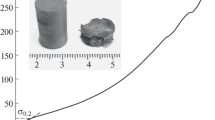Summary
-
1.
The methods of mercury porosimetry, air pumping, and filtration of rarefied gas were used to determine the effective pore radii, coarse and fine pore volumes, and specific surface for sintered porous nickel materials.
-
2.
A model has been proposed for the porous structure of the materials investigated, which takes into account the method of their preparation. The model comprises fine pores-spaces between the carbonyl nickel particles, having radii of the order of a few microns, as well as coarse poresvoids remaining after the vaporization of particles of the pore-forming agent, the size of which is of the order of hundreds of microns (up to 1 mm).
-
3.
Using the model proposed, an analysis is made of the character of the relationship between the principal structural characteristics of specimens and the amount and particle size of the pore-forming agent employed in their preparation. Conditions under which a system of interconnecting coarse pores can exist in material have been determined.
-
4.
The model proposed provides a satisfactory explanation of relationships between various structural characteristics measured by different methods; this confirms that the model is a faithful representation of the true structure of the specimens investigated.
Similar content being viewed by others
Literature cited
F. T. Bacon, Col.: Fuel Cells, Editor Young [Russian translation], IL, Moscow (1963), p. 75.
R. Kh. Burshtein, A. G. Pshenichnikov, and N. A. Shumilova, Dokl. Akad. Nauk SSSR,143, 1409 (1962).
G. Feuillage, J. Chim. Phys. et Phys-chim. Biol., 60, 613 (1963).
F. P. Dousek, J. Jindra, and M. Svata, Collect. Czechosl. Chem. Communs.,29, 2232 (1964).
O. K. Davtyan, Col.: Fuel Cells. Some Theoretical Problems [in Russian], “Nauka” Press, Moscow (1964), p. 49.
O. S. Ksenzhek, E. A. Kalinovskii, and E. L. Baskin, Zh. Prikl. Khim.,37, 1045 (1964).
O. S. Ksenzhek and E. A. Kalinovskii, Zh. Prikl. Khim.,37, 541 (1964).
O. S. Ksenzhek and E. A. Kalinovskii, Zh. Prikl. Khim.,37, 1256 (1964).
O. S. Ksenzhek, E. A. Kalinovskii, and L. P. Tsyganok, Zh. Fiz. Khim.,38, 2587 (1964).
O. S. Ksenzhek, E. A. Kalinovskii, and V. P. Tysyachnyi, Zh. Prikl. Khim.,37, 2619 (1964).
V. V. Stender, Diaphragms for the Electrolysis of Aqueous Solutions [in Russian], State Scientific and Technical Press for Chemical Literature, Moscow-Leningrad (1948).
B. V. Deryagin, N. N. Azkhavaeva, M. V. Talaev, and V. V. Filippovskii, Col.: Methods of Investigating the Structure of Highly-Dispersed and Porous Materials, No. 2 [in Russian], Acad. Sci. USSR Press, Moscow (1958), p. 203.
T. G. Plachenov, V. F. Karel'skaya, and M. Ya. Pulerovich, Col.; Methods of Investigating the Structure of Highly-Dispersed and Porous Materials, No. 2 [in Russian], Acad. Sci. USSR Press, Moscow (1958), p. 251.
Author information
Authors and Affiliations
Rights and permissions
About this article
Cite this article
Korovin, N.V., Magdasieva, M.E. & Solyakov, V.K. The structure of porous nickel electrodes made by the powder metallurgical method. Powder Metall Met Ceram 5, 373–379 (1966). https://doi.org/10.1007/BF00775992
Received:
Issue Date:
DOI: https://doi.org/10.1007/BF00775992




